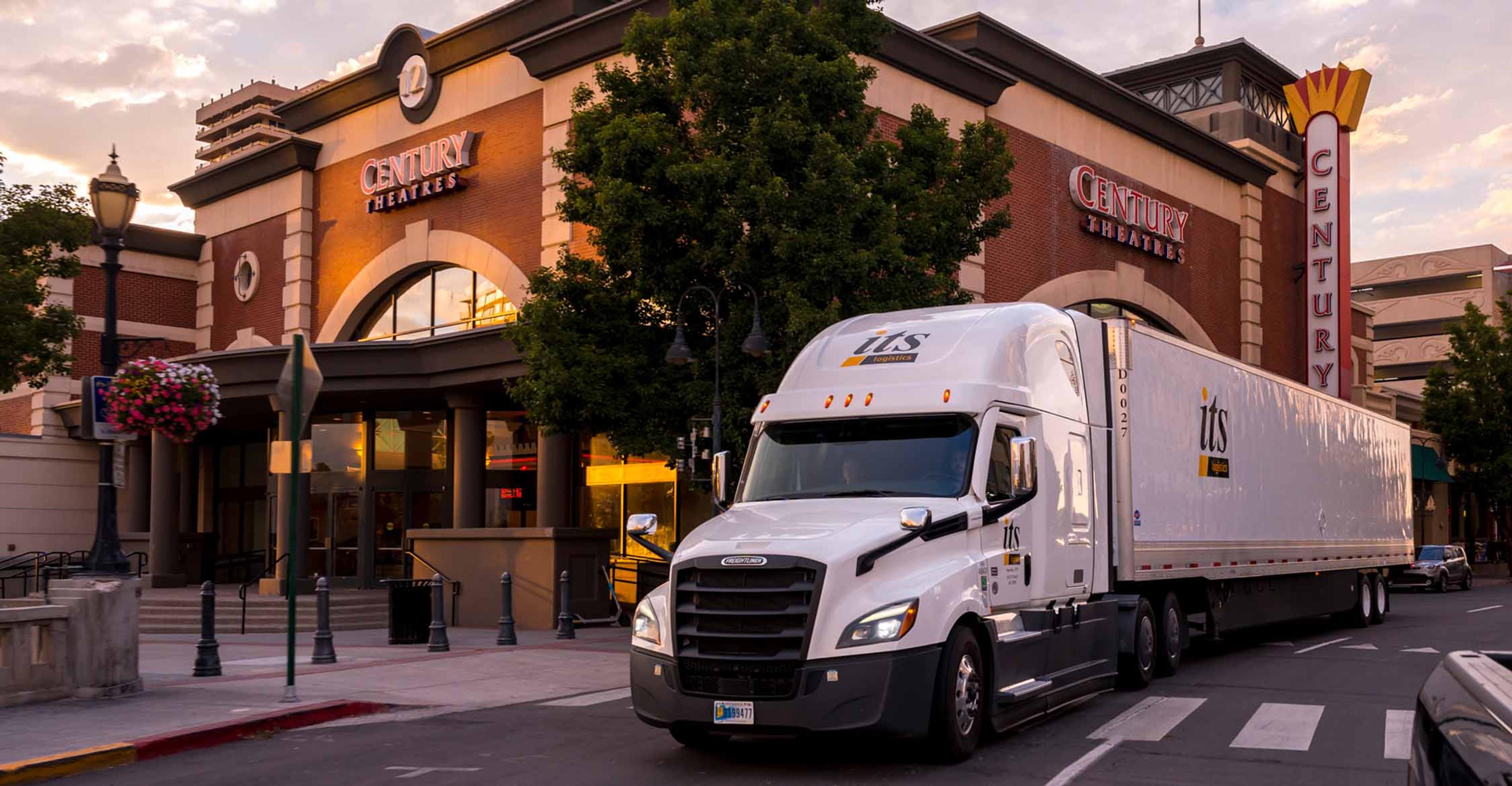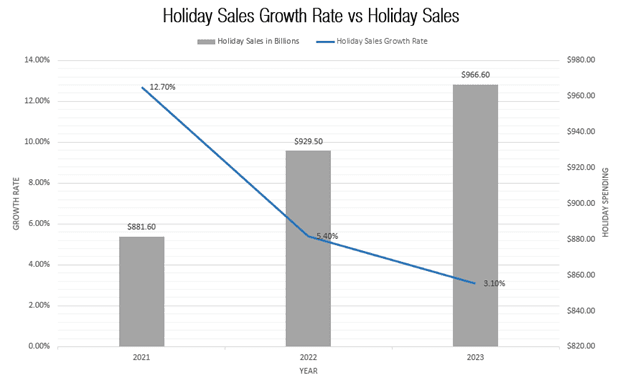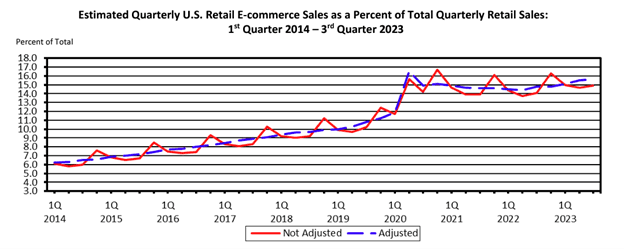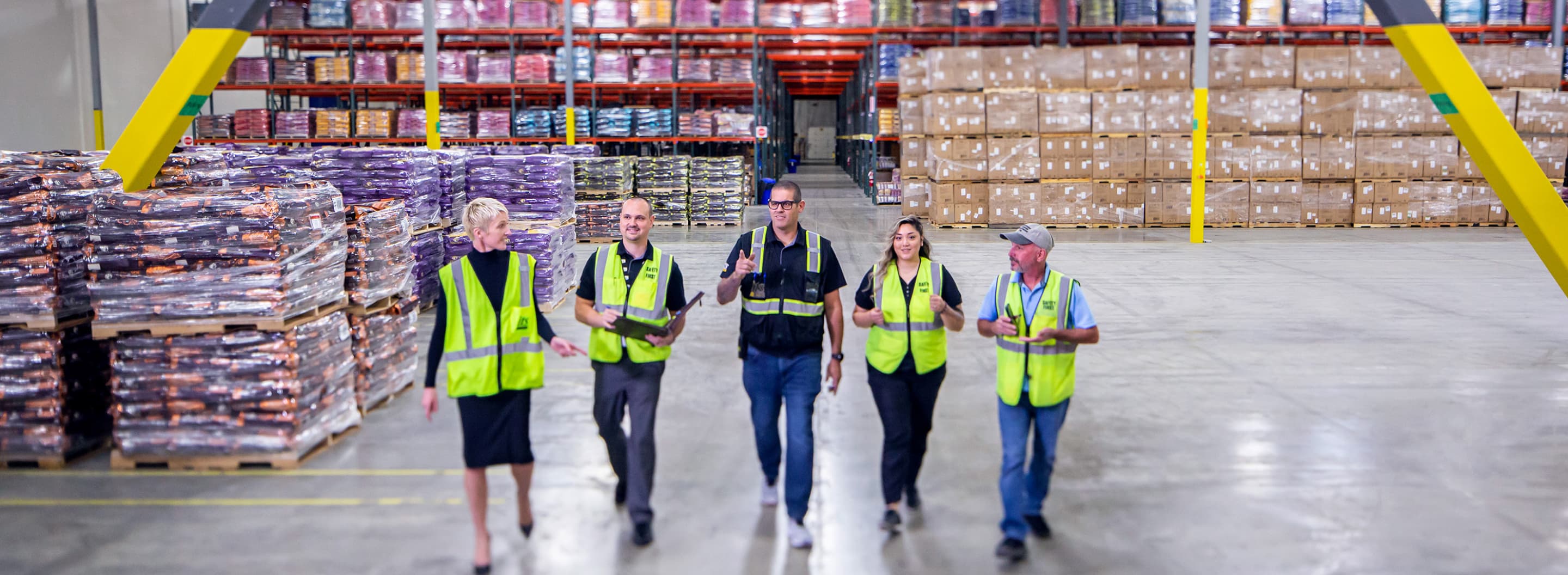Retail Trends in 2024 and a Retailer’s Guide to Successful Logistics

2023 was a challenging year for retailers, with excess inventory, throttled consumer spending, and mixed economic signals being some of the key themes. 2024 has the potential to further shake consumer confidence and be another bumpy year of uncertainty, with geopolitical disruptions currently looming over the Red Sea.
Here are several key areas retailers should be watching in 2024 and a look at how those areas could potentially impact supply chains.
Changing Consumer Behavior
Mindful spending became a main theme in 2023 and will likely continue to be in 2024. Despite inflation, holiday spending in 2023 outpaced the year before; the annual growth of spending continues, but the rate of growth is slowing and returning to pre-pandemic levels.
In 2021, holiday retail spending increased 12.7%, a 20-year high that was fueled by trillions of dollars in pandemic-related stimulus. That number decreased to 5.4% in 2022 and, according to data from MasterCard SpendingPulse, dropped again to 3.1% in 2023. Although 2023’s growth rate experienced a drop, 3.1% is more consistent with the average pre-pandemic growth rate of 3.6% from 2010 to 2019.

Consumer confidence ended the year on an optimistic note but remains far from where it was in 2019, according to a Consumer Confidence Index by The Conference Board. Even though the index showed growth, two-thirds of consumers surveyed for the index still perceived that a recession is possible. Credit card balances also spiked in Q3 of 2023, reaching a record $1.08 trillion according to CNBC.
What does this mean for supply chain in 2024?
As consumers get tighter and more mindful with their spending, running tighter, Just In Time (JIT) inventory strategies can help businesses avoid excess inventory issues and keep pace with consumer demand. However, it's equally important to apply sensible, Just In Case (JIC) strategies to inventory staples with consistent high demand.
Unrest in the Middle East around the Suez Canal and drought conditions in the Panama Canal could disrupt and delay imports, so it’s also important to have a contingency plan in place ahead of time to avoid delayed shipments.
Ecommerce
According to Census.gov data, ecommerce accounted for 14.9% of total retail sales in Q3 of 2023, which is a .9% increase from the previous quarter. See the graph below for ecommerce sales growth going back to 2014.

Of that 14.9% of retail sales, major online retailers—like Amazon, Walmart, Apple, eBay, and others—captured an approximate, combined 60% of ecommerce market share, with Amazon leading at 37.6%. That means direct-to-consumer ecommerce only accounted for 40% of ecommerce sales.
Consumers continue to shop online and, if they’re voting with their dollars, prioritize the convenience of marketplaces like Amazon. This isn’t news and has been the case for several years.
Social commerce—purchases made directly from social media platforms like Facebook, Instagram, and WeChat—has had a difficult time catching on in the US but is becoming more prevalent in countries like China. It’s estimated that social commerce will capture 5% of total US ecommerce sales by 2025 and reach $3 trillion globally by 2026.
What does this mean for supply chain in 2024?
The adoption boost from the 2020 pandemic is holding steady as ecommerce continues to evolve. Shoppers are embracing new online shopping experiences and channels, and it’s up to businesses to deliver an omnichannel experience across the digital shelf.
Two-day shipping, free returns, and flexible fulfillment options (buy online, pick up in store [BOPIS] and buy online return in store) are all table stakes for running an omnichannel, ecommerce business. From a supply chain perspective, cost effectively delivering an omnichannel experience comes down to having the right distribution network. An omnichannel distribution network should offer:
- Two-day reach to most of the US population
- Cost-competitive warehousing
- Scalability and agility
Visibility
Visibility was one of the top issues facing supply chains in 2023. In November, as a reaction to numerous supply chain disruptions, the White House announced 30 new actions to strengthen US supply chains. One of these actions was a new system for cross-governmental supply chain data sharing. On a similar note in a manufacturing survey, 42% of manufacturers intended to improve supply chain visibility in 2023, according to data by BDO. And to top it off, a 2022 report from Deloitte found that just 13% of organizations can map their entire supply chain network, and that up to 22% have no visibility beyond their immediate suppliers.
Organizations and businesses want to know what’s going on with their supply chain, and in 2024, the technology will be there to make multi-tier, end-to-end visibility happen.
What does this mean for supply chain in 2024?
With the integration of Internet of Things (IoT) and innovative spurred by disruptions, full, end-to-end, and real-time supply chain visibility is just now becoming a reality. Smart sensors and connected devices enable real-time monitoring of inventory, shipments, and even environmental conditions. This level of granularity not only minimizes the risk of errors but also allows for swift corrective actions in response to disruptions.
Businesses will have the opportunity to improve their supply chain visibility in 2024, but it’s going to require investment in technology to be successful.
Innovation
According to a survey from Gartner, 73% of 2023 supply chain IT budgets were allocated to growth and performance. Innovation was a main theme of supply chain in 2023 and will likely continue to be in 2024.
Some of the top strategic technology trends for 2023 included:
- Actionable AI
- Smart operations
- Composable application architecture
- Supply chain integration services
- Cyber resilient supply chains
- Industry cloud platforms
- Mobile asset optimization
- Employee engagement
What does this mean for supply chain in 2024?
Disruption from the last several years caused a boom in technological supply chain innovation, and the dust is still settling on which technologies are proven and reliable. There are two different types of businesses competing in this space, pure software providers and tech-forward 3PLs. 2024 will bring a collision course between those models and the business expertise of operators and the tech expertise of software companies.
There will likely be a consolidation as some technologies are proven and others fall by the wayside. For businesses looking to invest in reliable innovation, the best strategy will be to be a fast follower of proven technologies.
Build a more resilient supply chain with ITS Logistics
ITS Logistics has decades of experience providing creative solutions that help customers maximize their supply chain through every economic condition. With the highest level of service, unmatched industry experience and work ethic, and a laser focus on innovation and technology– the team at ITS strives to improve the quality of life for its partners by delivering excellence at every turn.
ITS Logistics maintains a high standard for distribution and fulfillment:
- 99.6% ASN Timeliness
- 99.8% Load Quality
- 99.8% ASN Accuracy
- 99.9% On-Time Shipping
- 99.4% Fill Rate
- 99.3% Pallet & Carton Labeling
Reach out to learn more about ITS Logistics and find a creative logistics solution that will work for your business.
How can we help you?



